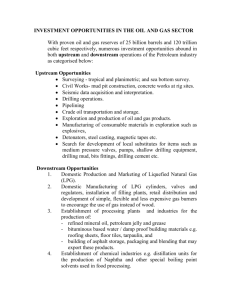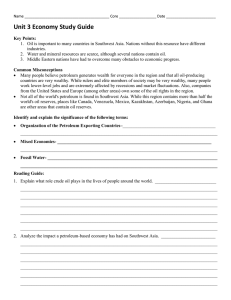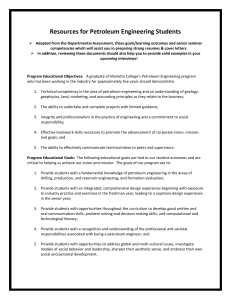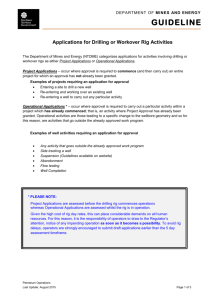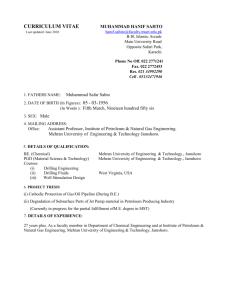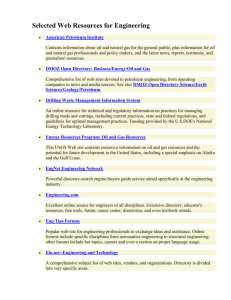Petroleum - Wilkes University
advertisement
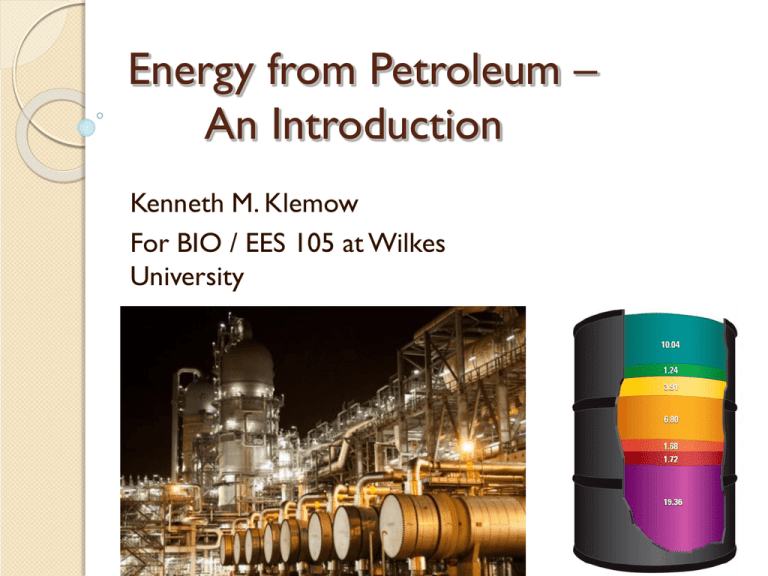
Energy from Petroleum – An Introduction Kenneth M. Klemow For BIO / EES 105 at Wilkes University What is petroleum? Thick flammable liquid, ranging from yellow to black Word derived from Greek ◦ Petros = rock ◦ Oleum = oil Petroleum includes a mixture of organic substances rich in carbon (and hydrogen) Natural gas (methane) Kerosene Gasoline Lubricating Paraffin Naphtha Asphalt Classification of petroleum Crude vs refined Light vs intermediate vs heavy Sweet vs sour How does it form? Oil in earth’s crust http://www.green-planet-solar-energy.com/fossil-fuel-formation.html How much oil is available? Need to consider: ◦ Reserves Different forms Proven and unproven By country Within US ◦ Production By country Within US Forms of oil availability Petroleum reserves worldwide http://sevencolors.org/images/photo/original/oilmap.jpg Petroleum reserves worldwide http://www.earthsci.org/education/teacher/basicgeol/fossil_fuels/fossil_fuels.html Proven vs Unproven Reserves http://prienceshrestha.wordpress.com/2012/01/01/the-geo-political-issues-regarding-global-oil-reserve/ World production by country U.S. Petroleum Reserves Production by state Extracting petroleum Three main steps ◦ Oil exploration ◦ Drilling ◦ Pumping Oil exploration Done by geologists ◦ Look for evidence of source and trap rock Interpret maps Test drilling Look for oil bearing strata Presence of certain micro-algae ◦ Additional methods Magnetometers / gravity meters Seismic testing “Sniffers” detect hydrocarbons in the air Oil drilling Clear land Secure source of water Install rig - derrick Commence drilling ◦ Drillbit ◦ Establish casing ◦ Introduce drilling mud http://www.encapgroup.com/drilling/ Pump oil from the ground Place pump at wellhead Place rods in the borehole Motor drives assembly Suction created in upstroke, drawing oil upward http://www.encapgroup.com/drilling/ Crude oil must be refined to separate components Done at fractionating column (cracker) Inside a column http://www.propertiesofmatter.si.edu/boilingoil.html Energy from petroleum products http://energy.gov/articles/hows-and-whys-replacing-whole-barrel History of Petroleum Oil well known in ancient world ◦ Ancient Babylonians, Greeks, Chinese used for paving streets, lighting, medicines, producing salt By middle ages, kerosene isolated, used for lighting In US, oil obtained in PA and NY from shallow pools. Petroleum in 19th Century Production increased greatly in US and Europe due to improved drilling technology ◦ Drake well in Titusville in 1859 ◦ Other wells in California, Europe, and Canada in next few years ◦ Development of internal combustion engine in late 1800s increased demand. Petroleum in 20th Century Demand and production increased throughout the first half of century. ◦ Cars, Trains, Planes, Home heating ◦ Rise of plastics Drilling increasingly shifted offshore Middle-Eastern countries became large-scale producers by 1950s. OPEC formed in 1960. Oil embargos in 1973 / 79 had worldwide economic impact. Environmental issues noted by 1980s. Focus on finding alternatives. Worldwide petroleum use over time Worldwide patterns of petroleum use – by country Petroleum use – US Petroleum use per capita http://www.realitybase.org/journal/2010/12/13/the-history-of-us-per-capitapetroleum-consumption-will-surp.html Benefits of petroleum as an energy source High energy density Convenient to transport Burns relatively cleanly Produces many forms of energy Byproducts common in our modern lives Drawbacks of petroleum as an energy source Often unreliable, especially if imported Drilling causes habitat impacts Spills can be devastating, ecologically Greenhouse gas emissions
